Traditional Japanese tattoos, known as Irezumi, stand as a profound and intricate art form, far beyond mere body decoration. Emerging during the Edo period (1600–1868) in Japan, Irezumi evolved from simple marks and symbols into elaborate imagery, becoming the sophisticated art we recognize globally today. This rich tradition uses the body as a canvas to depict mythical creatures, flora, and narratives drawn from folklore, myths, and legends, each design imbued with deep meaning and personal aspiration.
The flourishing of Irezumi art was intrinsically linked to the advancement of Japanese woodblock prints. Artists skilled in woodblock techniques began to apply their craft to tattooing, inspired by the vividly tattooed heroes depicted in popular prints. Wearing Irezumi was not just about aesthetics; it was, and remains, an embodiment of personal aspirations and life goals, etched permanently onto the skin.
Early Irezumi artists adopted many tools from woodblock printing, including chisels, gouges, and notably, Nara ink, also known as Nara black. This unique ink is famous for its transformative quality, appearing black initially but aging to a distinctive blue-green hue beneath the skin – considered the hallmark of authentic Irezumi.
The social context of Irezumi in its early days is a subject of scholarly debate. Some historians argue that these extensive tattoos were primarily worn by the lower classes of Edo society. Conversely, others propose that wealthy merchants, legally restricted from overtly displaying their affluence, embraced Irezumi as a hidden expression of wealth beneath their garments. Regardless of the initial wearers, Irezumi undeniably became associated with and proudly displayed by firemen, the daring figures of Edo. Revered for their bravery and roguish charm, firemen wore Irezumi as a form of spiritual armor, seeking protection and aid. The iconic “Suit of Nine Dragons,” for instance, was believed to grant power over wind and water, crucial elements for those battling fires in densely built Edo cities.
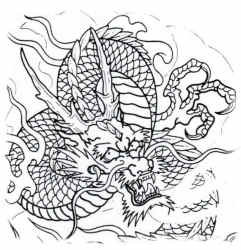 Ryu Dragon tattoo, symbol of wisdom and strength in Irezumi
Ryu Dragon tattoo, symbol of wisdom and strength in Irezumi
Tattoos in Modern Japan: Navigating Tradition and Stigma
The Meiji Restoration in 1869 marked a significant turning point for Japanese tattoos. As Japan sought to modernize and present a refined image to the Western world, the government outlawed tattooing. Consequently, Irezumi acquired connotations of criminality. Despite this official prohibition, the allure of Irezumi persisted, particularly among fascinated foreigners who journeyed to Japan seeking the expertise of traditional tattoo artists. This demand ensured that traditional tattooing continued, albeit underground. Anecdotal evidence even suggests that King Edward VII of Britain commissioned a Japanese tattoo artist to tattoo dragons on his forearms and subsequently sent the artist to New England to tattoo his American friends, as a gesture of goodwill and camaraderie.
The legal ban on tattooing was eventually lifted by the Allied occupation forces in 1945. However, the stigma associated with tattoos, particularly Irezumi, endured. For many years, traditional Japanese tattoos became strongly linked to the Yakuza, Japan’s infamous organized crime syndicates. This association led to ongoing social discrimination. Even today, many businesses in Japan, such as public baths (onsen), fitness centers, and hot springs, maintain policies that ban customers with visible tattoos.
Despite these societal challenges, traditional Irezumi persists as a highly respected art form. Practiced by specialized tattooists, the process is known for being painful, exceptionally time-consuming, and expensive. A full-body Irezumi suit, encompassing the vest or jacket area, sleeves, and pants, while traditionally leaving an un-tattooed space down the body’s center, can take anywhere from one to five years to complete, requiring weekly sessions. Committing to such an extensive and demanding process is seen as a testament to perseverance and dedication. The imagery chosen for an individual’s Irezumi is deeply personal, reflecting their aspirations, character, and life philosophy.
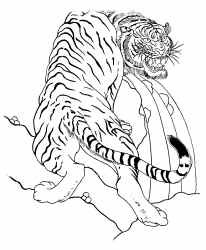 Tora Tiger tattoo, representing courage and warding off bad luck in Japanese tradition
Tora Tiger tattoo, representing courage and warding off bad luck in Japanese tradition
Deciphering the Symbolism: Meanings Behind Irezumi Motifs
Understanding the symbolism within Irezumi is crucial to appreciating its depth. While numerous symbols are employed, their combination and context dictate the ultimate meaning of each tattoo. Choosing a tattoo artist specializing in Irezumi with a comprehensive knowledge of these symbols is paramount to ensure the tattoo accurately represents the intended meaning. Misinterpretations or poorly executed symbolism can lead to unintended and permanent misrepresentations.
Ryu (Dragon)
Contrary to Western depictions of dragons as greedy, fire-breathing, and fearsome, the Japanese dragon, or Ryu, symbolizes wisdom, strength, and benevolence. Oriental dragons are equally comfortable in the sky and water, often seen as manipulating universal forces for humanity’s benefit. Their appearance is a composite of various animals, embodying characteristics encountered throughout their long lives. A dragon’s eyes may resemble a demon or rabbit, ears like a cow, neck and belly of a snake, horns of a stag, and scales of a koi. Talons are from a hawk or eagle, breath like perfume, and voice like melodious bells. Japanese dragons are considered bearers of blessings, and choosing a dragon in Irezumi often signifies an aspiration for goodness, wisdom, and power.
The color of a dragon’s scales indicates age; colored scales suggest a dragon at least 500 years old, while younger dragons lack colored scales. Dragons living over 1000 years may develop feathered wings similar to a phoenix. Oriental dragons are rarely malevolent; instead, they embody strength combined with wisdom and are typically benevolent figures. A dragon clutching a pearl or jewel, often depicted as a “closed-lotus form,” represents control over the universe’s elements – winds, rain, fire, and planets. This motif, also found in Buddhist art, symbolizes the dragon’s role in protecting universal spiritual essence.
Koi (Carp)
The Koi carp holds a revered position in Japanese culture, far beyond being just a decorative fish. It’s a central figure in numerous myths and legends, celebrated for its masculine qualities. Koi are known for their bravery in climbing waterfalls, and legend says if caught, they face the knife stoically, much like a warrior facing a sword. This stoicism and courage have associated koi with masculine virtues, leading to their adoption for Japan’s annual “Boys’ Day Festival,” where koi streamers are flown for each son. In Irezumi, especially with flowing water, koi symbolize courage, perseverance, and the ability to overcome life’s challenges to achieve goals.
Longmen Falls (Dragon’s Gate)
A significant legend from ancient China narrates that any koi successfully climbing the falls at Dragon Gate on the Yellow River transforms into a dragon. This legend has made the koi a potent symbol of worldly ambition and advancement. However, not all koi are destined for Dragon Gate. Another popular tale features a giant koi terrorizing a village, ultimately defeated by a young boy, Kintaro, who becomes a folk hero.
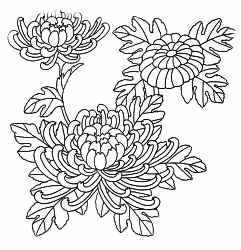 Koi Carp tattoo, symbolizing courage, perseverance, and aspiration in Irezumi
Koi Carp tattoo, symbolizing courage, perseverance, and aspiration in Irezumi
Tora (Tiger)
In Chinese tradition, the tiger reigns supreme among land animals, embodying strength, courage, and longevity. Tigers are also believed to ward off misfortune, disease, and demons. Depictions often show tigers alongside Shoki the demon queller, fighting demons (Oni). The tiger is one of the four sacred animals, symbolizing the North, autumn, and control over the winds.
Karashishi (Fu Dog / Lion Dog)
Often mislabeled as dogs, Karashishi, or Fu Dogs, are actually lions, more accurately termed “Lion of Buddha.” Also known as Foo Dog, Foo Lion, Fu Lion, Lion Dog, and Shi-Shi Dog, these figures are prevalent in Asian art, sculptures, and Irezumi. While associated with Buddhism, their origins might predate it, rooted in Japanese Shinto beliefs where a red-headed lion protector wards off evil spirits and brings health and wealth. Regardless of origin, the Fu Lion is fundamentally a symbol of protection, strength, and courage. Legend claims lion mothers test their cubs by throwing them from cliffs, ensuring only the strongest survive. Fu Dogs often appear in pairs, guarding entrances, depicted seated yet alert. The male Fu Dog, typically on the right, has an open mouth (to release evil) and rests a paw on a sphere representing heaven and Buddhist law. The female, on the left, has a closed mouth (to keep evil in) and a paw on a cub (representing earth). In Irezumi, Fu Lions are often tattooed crawling protectively up limbs, symbolizing heroic aspiration and mental fortitude. Their dog-like appearance is likely due to early Asian artists’ limited exposure to actual lions, relying on second-hand descriptions, as lions are not native to Asia.
Hou-ou (Phoenix)
The Phoenix, or Hou-ou, is arguably the most significant mythological bird, renowned for its unmatched splendor and immortality, achieved through rising from its own ashes. The name derives from the Greek word for “red,” the color of fire, and its origins trace back to Ethiopia, believed to appear only every 500 years. In ancient China, the Feng-huang bird symbolized yin and yang unity and marriage. Ancient Rome used it on coins to represent imperial endurance. Stories vary; some say it gathers fragrant herbs, builds an altar, and immolates itself, rising again in three days. Others claim it builds a nest of aromatic twigs and combusts from its own heat as death approaches. Phoenix tattoos depict various stages of its existence, not always engulfed in flames. Regardless of the narrative, the phoenix symbolizes the undying soul, resurrection, immortality, triumph, and rebirth in this life.
Oni (Demon)
Oni, horned demons, are popular in contemporary Irezumi. They are among the most common supernatural beings in Japanese cosmology, typically portrayed as rampaging, violent, and cruel. Always horned, their faces vary, similar to Noh masks, and are often pink, red, or blue-grey. Oni are fearsome supernatural creatures, described as guardians of Buddhist hell, torturing demons, and punishers of the wicked. They are also depicted as pranksters, man-eaters, sinner-hunters, and harbingers of disease. However, the gods of wind (Fujin) and thunder (Raijin), often depicted as Oni looming on clouds, demonstrate that Oni are not inherently evil. They carry out duties assigned by powerful deities. Oni King, or Onijin, is a powerful Oni king, sometimes depicted as self-absorbed but capable of being overcome by righteous forces to restore balance. Older tales also portray Oni as benevolent protectors, such as monks transforming into Oni after death to guard temples.
Zugaikotsu (Skull)
Skull tattoos in Irezumi carry deeper meanings than just death, danger, or fear. Originally, they symbolized “great change” and “celebration of a great life,” representing mortality’s acceptance and embracing new beginnings. Skulls honored the deceased and significant life transitions. Their association with death likely arose because death is the ultimate change. Unfortunately, today, the skull’s true meaning is often misunderstood, linked to negativity. However, understanding its traditional significance reveals a symbol of transformation rather than morbidity.
Hannya
The Hannya mask, from Noh theatre, represents a vengeful, jealous woman transformed into a demon, yet retaining human traces. Noh theatre, developed in 14th-century Japan, uses stylized masks to convey character and mood in traditional stories. The Hannya mask, with pointed horns, glaring eyes, and fangs, expresses intense resentment and hate, balanced by suffering around the eyes and disheveled hair indicating emotional turmoil. Deeper mask colors signify more profound emotions. Irezumi utilizes Hannya masks in larger compositions, sometimes juxtaposing them with benevolent masks. A solitary Noh mask can also be a standalone artwork, mirroring the collectible nature of actual Noh masks. In Japan, raising two index fingers to the forehead signifies a jealous wife, referencing the Hannya. Redder masks indicate stronger anger, while paler ones suit less intense jealousy. The Dodoji play features a Hannya representing unrequited love, turning into a serpent and destroying a temple bell and priest. Blackened teeth on a Hannya mask symbolize rejecting beauty to all but her beloved, indicating focused, intense emotions. Japanese myths often have dual meanings, and anger can stem from despair, emphasizing the need for understanding and compassion.
Namakubi (Severed Head)
Namakubi, severed heads, in Irezumi, convey courage, a warning, respect for foes, and fearlessness. They symbolize accepting fate with honor. While brutal, Namakubi tattoos are not just shock value; they represent the cycle of life. Taking a head is done with respect for the person and their cause, but also warns of consequences for unrighteous living.
Hebi (Snake)
Snakes are arguably the most symbolically rich animals, believed to possess supernatural abilities like protecting against illness, disaster, and bad fortune. Like dragons, they can bring rain and sense impending negative consequences, leaving places deemed “not right.” Snakes are sometimes depicted transforming into human forms, often jealous or wronged women. Not all snake myths are negative; shop owners often display a snake coiled around a mallet to attract good fortune. Snakes are associated with wisdom and prophecy, and snakes in homes are welcomed as good luck, embodying ancestral protector spirits. In the Chinese zodiac, those born in the Year of the Snake are enigmatic and wise, characterized as thinkers and philosophers, fond of conversation and intelligent discussion, though easily bored and resistant to advice. Snake people are analytical yet decisive. Snakes in Irezumi represent protection and transformation, their symbolism centered on change, mirroring their life cycles. They embody earth and life-giving waters, representing both strength and adaptability.
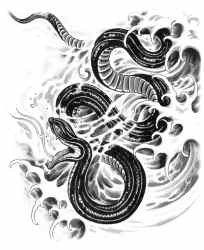 Hebi Snake tattoo, symbol of protection, wisdom and good fortune in Japanese Irezumi
Hebi Snake tattoo, symbol of protection, wisdom and good fortune in Japanese Irezumi
Botan (Peony)
The Peony, “King of Flowers,” signifies elegance and wealth. Its large, delicately curled petals have earned it the title “rose without thorns.” While often depicted in deep red in Irezumi, peonies now come in various colors. Despite the complex and extensive imagery in Japanese tattoos, the floral repertoire is selective. The peony, a favored choice, symbolizes wealth, good fortune, and prosperity, also suggesting a daring, devil-may-care attitude, contrasting with its Western connotations.
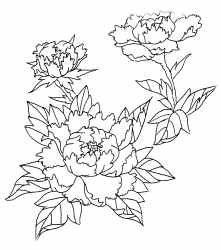 Botan Peony tattoo, symbolizing wealth, elegance and good fortune in Irezumi designs
Botan Peony tattoo, symbolizing wealth, elegance and good fortune in Irezumi designs
Momiji (Maple Leaf)
Japanese maple leaves, Momiji, are popular Irezumi backgrounds, symbolizing time passing and the wind. Designs often depict floating leaves carried by wind or water. In Japan, they also symbolize lovers. Maple leaf canopies are tattooed over shoulders and torsos. Single or multiple leaves represent regeneration and resurrection through seasonal cycles. Changing seasons, marked by leaf transformation, vividly remind of life’s circle. Spring, summer, autumn, and winter symbolize life and death. A tree losing leaves in autumn’s wind poignantly reflects human life’s transience, stirring poets and philosophers. “This too shall pass,” as Buddha said, meditating on a decaying leaf reminds of life’s impermanence.
 Momiji Maple Leaf tattoo, symbol of time passing and change in Japanese tattoos
Momiji Maple Leaf tattoo, symbol of time passing and change in Japanese tattoos
Kiku (Chrysanthemum)
The Chrysanthemum, or Kiku, symbolizes perfection. The Japanese revere it as their “solar flower,” adopted by the Imperial Family as their emblem, and the Emperor’s Seal. The Emperor’s position is called the Chrysanthemum Throne. The flower’s radiating petals symbolize the sun, with the center representing the Emperor’s status. Chrysanthemums embody longevity and joy, attributes of both the flower and a worthy ruler. The Imperial Order of the Chrysanthemum is Japan’s highest chivalry order. Japan also celebrates National Chrysanthemum Day, the Festival of Happiness. Autumn is its season, and in China, it symbolizes Taoist simplicity and perfection, a time of tranquility and abundance after harvest. Blooming into winter, it mediates life and death, heaven and earth. Traditional Irezumi, despite seeming chaotic, draws from a limited set of symbols, including chrysanthemum, cherry blossom, and peony. Chrysanthemums symbolize withdrawal and retreat, fitting autumn’s qualities and contemplation. Its Chinese name “chu” or “ju” sounds like “wait” or “linger.” Its solar, symmetric shape with radiating rays symbolizes life and longevity, contrasting cherry blossoms’ transience. Chrysanthemums represent not just long life but a complete, happy one.
Sakura (Cherry Blossom)
Cherry blossoms, Sakura, often appear in Irezumi alongside other imagery, sometimes overshadowing their delicate beauty. However, centuries of Japanese tattoo tradition have formalized this usage. Sakura’s powerful symbolism represents life itself. Their brief, beautiful flowering and petal scattering symbolize life’s fragility, like human existence. Their transient life and indifference to worldly pleasures represent the ideal warrior’s death, and their individual beauty mirrors human beauty. Sakura symbolizes mortality, love, beauty, and sudden death, a good omen in Japan. Sakura viewing, Hanami, is a national event where people gather to celebrate spring under blooming trees.
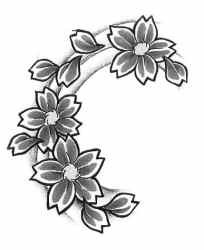 Sakura Cherry Blossom tattoo, symbol of the fleeting nature of life in Irezumi
Sakura Cherry Blossom tattoo, symbol of the fleeting nature of life in Irezumi
Hasu (Lotus)
Lotus flowers, Hasu, are deeply symbolic in Asian religions, especially in India, representing spiritual awakening. Their meaning varies slightly across myths, but religious traditions emphasize the lotus flower’s significance. In modern times, lotus tattoos symbolize life in general. Growing from mud into beauty, the lotus represents personal growth and transformation, symbolizing life’s struggles and the potential for beauty to emerge from hardship. Lotus and peonies are popular among Irezumi artists, complementing Koi tattoos. Koi and lotus are often found in temple ponds. Koi symbolize strength and individuality, making lotus and koi combinations rich in symbolic meaning within Irezumi.

